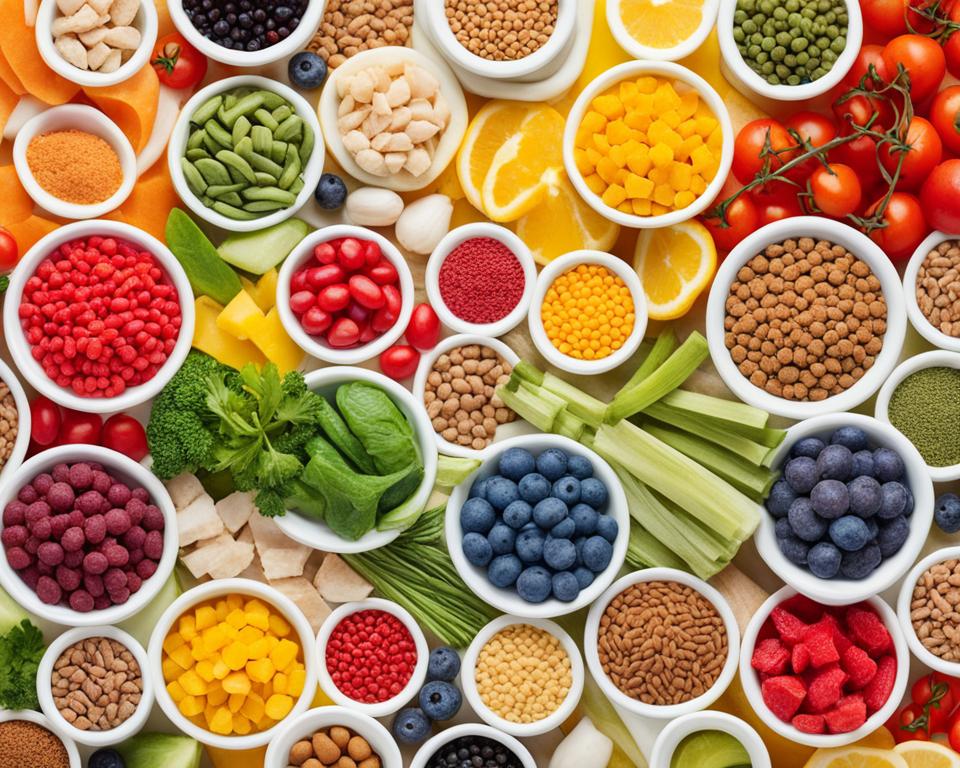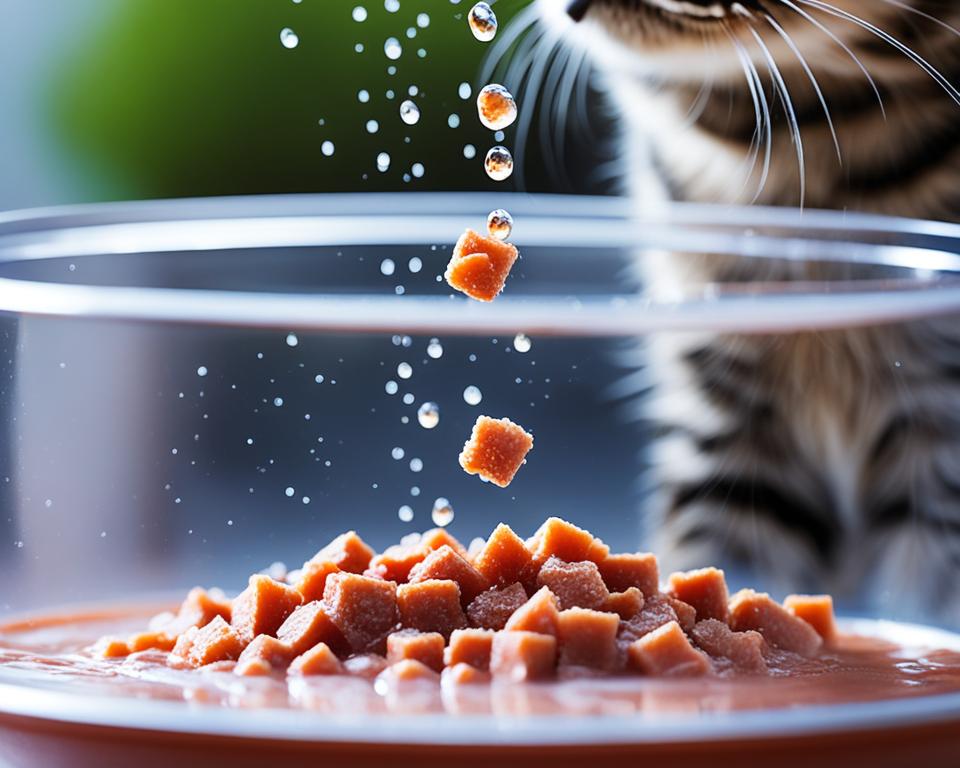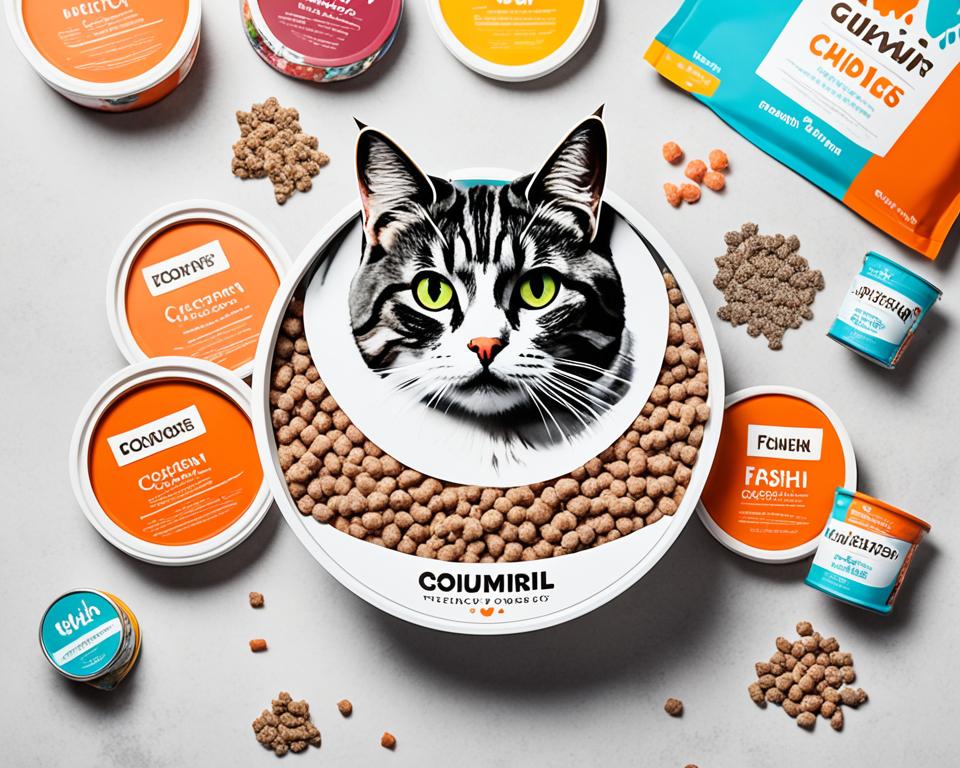I always thought a well-fed cat is a happy cat. As someone who loves feline nutrition, I’ve learned picking the right cat food is key. Today, I’ll share tips on choosing the best pet supplies for your kitty’s happiness.
Cats need special diets because they are unique. They do best on high-protein foods. Experts say they should get more protein than fat and not much carbs. They need about 200 to 250 calories a day, mostly from animals.
When I shop for cat food, I look for products with meat as the first ingredient. Good options have over 30% protein. This makes sure our cats get the right nutrients. It’s interesting to see how different brands mix protein, fat, and fiber to meet these needs.
Whether you like wet or dry cat food, the main thing is to give a complete and balanced diet. I’ve found mixing both types is best. It gives the hydration from wet food and the dental benefits of dry kibble. Let’s explore more about feline nutrition!
Understanding Your Cat’s Nutritional Needs

Feline nutrition is key for our furry friends’ health and happiness. Cats need a special diet that’s different from other pets. Let’s look at what makes a balanced cat food diet.
Protein Requirements for Felines
Cats must have high-quality animal protein to stay healthy. The Association of American Feed Control Officials (AAFCO) sets the minimum protein levels for cat food:
- Adult maintenance: 26% crude protein (dry matter basis)
- Growth and reproduction: 30% crude protein (dry matter basis)
Good protein sources in cat food are chicken, fish, and beef. These give cats the amino acids they need, like taurine. Taurine is good for the heart and eyes.
Essential Vitamins and Minerals
A balanced cat food must have important nutrients cats can’t make themselves:
- Vitamin A: Important for vision and immune health
- Niacin: Cats need more of this than dogs do
- Arachidonic acid: Key fatty acid for skin and coat health
The Importance of Hydration
Hydration is crucial for cats, especially those eating dry food. Cats don’t drink much, so their food should have moisture. Wet cat food can help them drink more, keeping their urinary and kidney health good.
| Nutrient | Function | Source |
|---|---|---|
| Protein | Muscle maintenance, energy | Meat, fish, poultry |
| Taurine | Heart and eye health | Animal-based proteins |
| Vitamin A | Vision, immune function | Liver, fish oils |
| Arachidonic acid | Skin and coat health | Animal fats |
Knowing these nutritional needs helps us choose the best diet for our cats. This ensures they get the best nutrition for a happy, healthy life.
Types of Cat Food: Wet vs. Dry

Choosing the right cat food can be tricky. It’s key to know the differences between wet and dry cat food for your cat’s health. Let’s look at the benefits of each type and how they can work together for a balanced diet.
Benefits of Wet Cat Food
Wet cat food is a top pick for many cat owners. It has about 75-78% water, which helps keep cats hydrated. This is great for cats with urinary tract or kidney issues.
- Higher protein content
- Lower carbohydrate levels
- Easier to digest
- More palatable for picky eaters
Advantages of Dry Kibble
Dry cat food, or kibble, also has its benefits. It has only 6-10% moisture, so it lasts longer and is easy for busy owners. Some dry foods even help clean your cat’s teeth, which is good for their oral health.
- Cost-effective
- Convenient for free-feeding
- Helps maintain dental health
- Longer shelf life
Combining Wet and Dry Diets
Many experts suggest mixing wet and dry cat food for a balanced diet. This way, you get the benefits of wet food’s hydration and taste with the ease and dental perks of dry food.
| Aspect | Wet Cat Food | Dry Cat Food |
|---|---|---|
| Moisture Content | 75-78% | 6-10% |
| Calorie Density | Lower | Higher |
| Shelf Life | Short (24 hours once opened) | Long (weeks to months) |
| Dental Benefits | Limited | Can help clean teeth |
Every cat is different. Think about your cat’s age, health, and likes when picking between wet, dry, or a mix of both.
Cat Food Ingredients: What to Look For
When I shop for natural cat food, I check the ingredients first. Premium cat food should have a specific meat source as the main ingredient. Look for names like chicken, turkey, or salmon. These proteins are crucial for our feline friends, who are obligate carnivores.
Cats don’t need carbs, and many struggle to digest them. That’s why I avoid foods with grain-based fillers like corn or wheat. Instead, I opt for cat food with named fat sources, such as chicken fat or fish oil.
Quality cat food ingredients often include essential vitamins and minerals. Vitamin E and C are common preservatives. I always ensure the food contains taurine, a vital amino acid for cat health. Without it, cats can develop serious health issues.
- Look for specific protein sources (chicken, turkey, lamb, salmon)
- Avoid unnamed meat by-products and excessive fillers
- Check for essential nutrients like taurine
- Opt for foods with high moisture content
I prefer wet food for my cat’s main diet, using dry kibble as occasional treats. Wet food helps keep cats hydrated and can prevent urinary tract issues. When choosing premium cat food, I aim for options with at least 25% protein and 20-24% fat content.
Remember, the best cat food mimics a cat’s natural diet. A mouse, for example, is about 55.8% protein and 23.6% fat – an ideal meal for our feline companions. By focusing on these key cat food ingredients, we can ensure our pets get the nutrition they need to thrive.
Selecting Age-Appropriate Cat Food

Choosing the right food for your cat is key at every stage of life. Cats’ nutritional needs change as they grow. So, it’s vital to adjust their diet as they age.
Kitten Nutrition
Kittens need food full of protein and fat for their fast growth. By 3-4 weeks, they start eating solid food. Feed them 1/2 to 1 cup of dry kitten food or 6-9 ounces of wet kitten food a day. Make sure it’s split into at least 3 meals.
Adult Cat Dietary Needs
Adult cats need food that keeps them at a healthy weight and gives balanced nutrition. Most cats become adults at 1 year. But, some big breeds may need kitten food until they are 18-23 months old. I feed my adult cats twice a day, as my vet suggests.
Senior Cat Food Considerations
Senior cats, which are usually 7-10 years old, need fewer calories but more nutrients. I choose wet food for my older cats with dental problems. It’s key to watch how much they eat to avoid overeating.
| Life Stage | Age Range | Dietary Focus |
|---|---|---|
| Kitten | 0-6 months | High protein, high fat |
| Junior | 6 months-2 years | Balanced nutrition |
| Adult | 3+ years | Weight maintenance |
| Senior | 11+ years | Lower calories, higher nutrients |
When changing your cat’s food, do it slowly over 7-14 days. Always talk to your vet for advice on what’s best for your cat’s diet.
Addressing Special Dietary Concerns
Some cats need special diets. Grain-free cat food is popular for cats with sensitivities. Grains aren’t bad for most cats, but some can’t digest them well. If your cat has tummy troubles, grain-free options might help.
For cats with digestive issues, sensitive stomach cat food is an option. These foods have proteins that are easy to digest and fiber to soothe upset stomachs. Purina ONE offers special blends for cats with sensitive stomachs.
Let’s look at some numbers:
- 7-10 days: The typical time it takes to transition a cat to new food
- 10-14 days: Recommended transition period for sensitive stomach cat food
- 8-16: The number of small meals cats prefer to eat throughout the day
Talking to a vet before changing your cat’s diet is a good idea. They can find out why your cat is sensitive and suggest the best food. Remember, every cat is different, so what works for one might not work for another.
“Monitoring your cat’s response during a diet transition is crucial to ensure they are adjusting well to the new food.”
When thinking about changing your cat’s diet, watch for signs like vomiting, diarrhea, skin problems, or lethargy. These signs might mean your cat needs a different diet. With patience and the right food, your cat can feel better and thrive.
Cat Food for Specific Health Issues
As a cat owner, I’ve learned that our feline friends sometimes need special diets. Premium cat food brands now offer tailored options for various health concerns. Let’s explore some common issues and how the right food can help.
Weight Management Formulas
Obesity is a huge problem for cats, often leading to arthritis and diabetes. I’ve found that weight management formulas, like those in some natural cat food lines, can be a game-changer. These foods typically have higher protein and fiber content. This helps cats feel full while consuming fewer calories.
Sensitive Stomach Options
For cats with delicate tummies, easily digestible foods are key. Many premium cat food brands now offer limited ingredient diets (LID) with novel proteins like rabbit or duck. These can be easier on sensitive stomachs and help reduce allergic reactions.
Urinary Tract Health
Urinary issues are common in cats. Foods designed for urinary health often have controlled mineral levels to maintain proper pH balance. I’ve noticed that increasing moisture intake is crucial. So, wet food or adding water to dry kibble can make a big difference.
Remember, treats should make up no more than 10-15% of your cat’s daily calories. When introducing new cat treats or food, do it gradually and watch for any adverse reactions. Always consult with your vet before making significant changes to your cat’s diet, especially if they have specific health concerns.
| Health Issue | Key Dietary Factors | Recommended Food Type |
|---|---|---|
| Weight Management | High protein, low fat | Dry kibble with lean proteins |
| Sensitive Stomach | Limited ingredients, novel proteins | Wet food with single protein source |
| Urinary Health | Controlled minerals, high moisture | Wet food or hydrated dry food |
Top Brands and Recommendations for Cat Food
Royal Canin is a top choice for premium cat food. They have 130 varieties, including 22 for special conditions and 8 for specific breeds. Their food fits all life stages, making it easy to find the right food for your cat.
Purina Gourmet is great for those who prefer natural cat food, especially wet food. They offer 60 varieties of fish, poultry, game, and meat in different textures. This variety is sure to please even the pickiest eaters.
For those on a budget, Whiskas offers great value without sacrificing quality. They have both wet and dry food for different life stages. You can choose from various flavors and packaging sizes.
Hills Science Plan Kitten Food is perfect for growing kittens. Royal Canin Digestive Care Food is great for cats with sensitive stomachs. These brands focus on quality ingredients, nutrition, and customer satisfaction.
New options are coming to the cat food market. Online services like Tails, Untamed, Republic of Cats, and Katkin are changing how we buy pet food. Republic of Cats offers a personalized plan for elderly cats, with dry and wet food tailored to their needs.
When picking a brand, think about your cat’s needs and likes. With so many quality options, you’ll easily find the best food for your cat. This ensures your furry friend stays happy and healthy.

